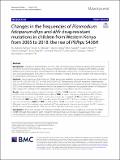| dc.contributor.author | M. Andreína Pacheco1, Kristan A. Schneider2 , Qiuying Cheng3 , Elly O. Munde4,5, Caroline Ndege4,6, Clinton Onyango4,6, Evans Raballah4,7, Samuel B. Anyona4,8, Collins Ouma4,6, Douglas J. Perkins3,4* and Ananias A. Escalante1* | |
| dc.date.accessioned | 2022-01-28T09:47:18Z | |
| dc.date.available | 2022-01-28T09:47:18Z | |
| dc.date.issued | 2020 | |
| dc.identifier.issn | (2020) 19:378 | |
| dc.identifier.uri | https://repository.maseno.ac.ke/handle/123456789/4733 | |
| dc.description | https://doi.org/10.1186/s12936-020-03454-8 | en_US |
| dc.description.abstract | Background: Sulfadoxine-pyrimethamine (SP) is the only anti-malarial drug formulation approved for intermittent
preventive treatment in pregnancy (IPTp). However, mutations in the Plasmodium falciparum dhfr (Pfdhfr) and dhps
(Pfdhps) genes confer resistance to pyrimethamine and sulfadoxine, respectively. Here, the frequencies of SP resistance-associated mutations from 2005 to 2018 were compared in samples from Kenyan children with malaria residing
in a holoendemic transmission region.
Methods: Partial sequences of the Pfdhfr and Pfdhps genes were amplifed and sequenced from samples collected in
2005 (n=81), 2010 (n=95), 2017 (n=43), and 2018 (n=55). The frequency of known mutations conferring resistance to pyrimethamine and sulfadoxine were estimated and compared. Since artemisinin-based combination therapy
(ACT) is the current frst-line treatment for malaria, the presence of mutations in the propeller domain of P. falciparum
kelch13 gene (Pfk13) linked to ACT-delayed parasite clearance was studied in the 2017/18 samples.
Results: Among other changes, the point mutation of Pfdhps S436H increased in frequency from undetectable
in 2005 to 28% in 2017/18. Triple Pfdhfr mutant allele (CIRNI) increased in frequency from 84% in 2005 to 95% in
2017/18, while the frequency of Pfdhfr double mutant alleles declined (allele CICNI from 29% in 2005 to 6% in
2017/18, and CNRNI from 9% in 2005 to undetectable in 2010 and 2017/18). Thus, a multilocus Pfdhfr/Pfdhps genotype with six mutations (HGEAA/CIRNI), including Pfdhps S436H, increased in frequency from 2010 to 2017/18.
Although none of the mutations associated with ACT-delayed parasite clearance was observed, the Pfk13 mutation
A578S, the most widespread Pfk13 SNP found in Africa, was detected in low frequency (2.04%).
Conclusions: There were changes in SP resistance mutant allele frequencies, including an increase in the Pfdhps
S436H. Although these patterns seem consistent with directional selection due to drug pressure, there is a lack
of information to determine the actual cause of such changes. These results suggest incorporating molecular | en_US |
| dc.publisher | BMC | en_US |
| dc.subject | Drug resistance genes, Dhfr, Dhps, k13 gene, SP resistance, Plasmodium falciparum | en_US |
| dc.subject | Drug resistance genes, Dhfr, Dhps, k13 gene, SP resistance, Plasmodium falciparum | en_US |
| dc.title | Changes in the frequencies of Plasmodium falciparum dhps and dhfr drug-resistant mutations in children from Western Kenya from 2005 to 2018: the rise of Pfdhps S436H | en_US |
| dc.type | Article | en_US |

